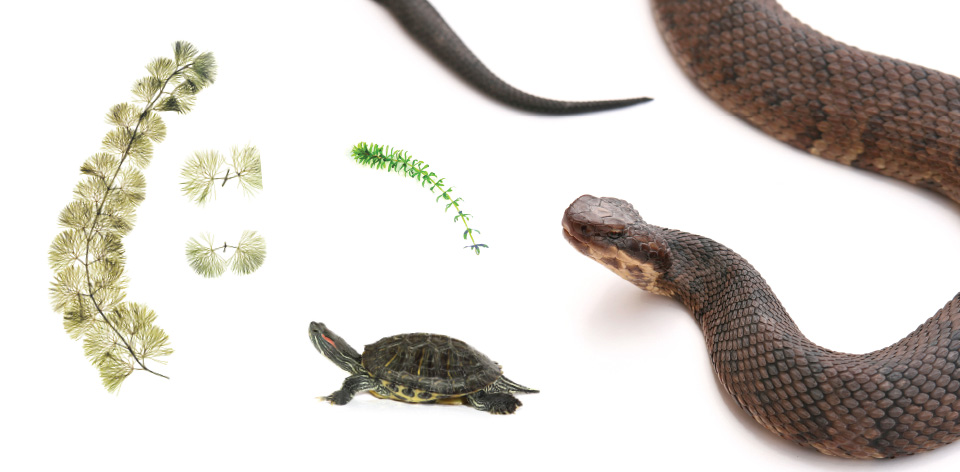What's in the Water Part II: Myth Busting Scary Animals and Plants

Animals
Three animals cause concern to local swimmers, but fatalities in the Austin area range from unheard-of to non-existent. These animals present more of an annoyance than a danger.
First Scary Animal: Snakes
Swimmers shouldn’t fear snakes as much as they do. Water moccasins, also called cottonmouths, are the only venomous snakes encountered in U.S. waters, and sightings are fairly rare. While most non-poisonous snakes have narrow heads indistinguishable from their necks, cottonmouths can be identified by their large, triangular heads. They can vary in color from black to light brown or even olive green. Some have bands of different colors, while others don’t. So color isn’t a good identifier.
These are solitary creatures that never mass into a writhing ball, despite the myth of water skiers falling into water moccasin nests and dying of snakebites—a tall tale dates back to the 1950s in Florida. The tale also appears in North Toward Home (1967) by Willie Morris, and irks readers or viewers of Lonesome Dove (1989), Larry McMurtry’s novel and TV miniseries. Contrary to popular belief, cottonmouths don’t nest or congregate in a ball. They give birth to live youngsters before leaving them to fend for themselves.
The rare swimmer who suffers from a snakebite will usually survive. For all types of venomous snakes in the U.S., there are an average of five deaths per year—or one death per 2,795 bites. That’s an annual death rate of .18 percent.
Swimmers will be safest if they swim in a group and splash around in a normal fashion. The commotion will scare away any nearby cottonmouths.
Cool fact: Cottonmouths got their common name from the white appearance inside their mouth.
Second Scary Animal: Turtles
The scariest thing about turtles is that while they’re swimming, their heads resemble snake heads. If one pops to the surface nearby, it may frighten you until you realize it’s not a snake. Since turtles can bite, you should take evasive action by splashing around and swimming away. In the water though, it is more common for snapping turtles to leave instead of attack.
Red-eared sliders are the most common turtle in Austin area waters, but many other species are also present.
Third Scary Animal: Leeches
You’ve probably only seen leeches only in movies. Texas leeches don’t resemble the large, brown blobs clinging to Humphrey Bogart in The African Queen or to the four boys in Stand by Me. Ours are very small, greenish animals that look like tiny plants. They don’t cause diseases, and it’s easy to brush them off your skin when you get out of the water. You can also sprinkle ordinary salt on them to make sure they let go. Not many bodies of water in the Austin area are known to contain leeches.
Plants
There are two plants that cause the most problems for local swimmers—one invasive and one native. Neither have been known to reach out and kill a swimmer, and no plant, despite sensational tales, can pull a swimmer under. However, a swimmer can sometimes become so entangled in weeds that he or she panics and can’t make their way out. In this case, it’s possible to get tired, sink, and drown.
First Scary Plant: Hydrilla
This invasive species has come close to taking over several local lakes. It’s quite troublesome to swimmers because it scratches, though hardly ever breaks, the skin, and often grows in thick clumps. It’s possible to swim through a big patch of hydrilla, but the experience isn’t pleasant. Julie Wolf, a Lago Vista resident and Ironman, hates swimming in thick vegetation so much that she avoids lakes known to contain hydrilla and fanwort. When she does have to swim in such a lake, she wears a wetsuit or a rashguard to minimize the scratchiness of the plants. Wolf said her "key to survival" is to keep her legs as high as possible and take shallow strokes. She detours around vegetation if she sees it and always swims with a safety kayaker in open water.
Hydrilla has a bad reputation in part because of misleading headlines, such as CBS’ “Attack of the Killer Weeds” headline from an article written in 2003. While hydrilla crowds out native vegetation and reduces fish populations, it doesn’t kill people. The best way to reduce hydrilla is to introduce sterile grass carp into the lake while lowering the water level annually so the weed dies.
Second Scary Plant: Fanwort
This native species is beneficial to local waterways because it increases oxygen levels, provides shelter and food for many aquatic animals, and helps to prevent the spread of hydrilla. It can look beautiful when the flat lilypad-like leaves fan out on the water’s surface and tiny white flowers bloom. However, it often looks bad in lakes around Austin because it collects trash and other debris. Overheard every year after the Capitol of Texas and TriRock Austin triathlons are complaints like, “I’m never swimming in that nasty water again.” The water is actually as clean as that in any local lake, but trash accumulates when people inappropriately discard plastic bottles and coffee cups.
Swimming through a patch of fanwort is similar to swimming through hydrilla, although fanwort is not scratchy and generally not as thick as hydrilla.
Most animals and plants in our local waterways are not dangerous, so there’s no need to fear an encounter. However, a little caution is always prudent. Open water swimming season will begin soon, so we hope you’ll swim with confidence knowing a little more about what’s in the water.






